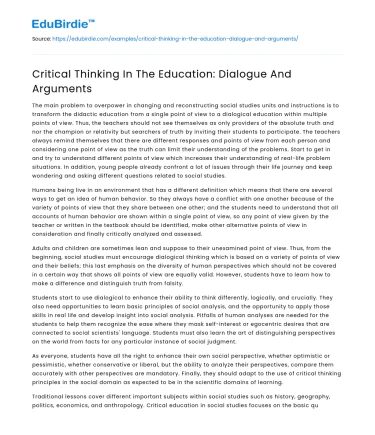The main problem to overpower in changing and reconstructing social studies units and instructions is to transform the didactic education from a single point of view to a dialogical education within multiple points of view. Thus, the teachers should not see themselves as only providers of the absolute truth and nor the champion or relativity but searchers of truth by inviting their students to participate. The teachers always remind themselves that there are different responses and points of view from each person and considering one point of view as the truth can limit their understanding of the problems. Start to get in and try to understand different points of view which increases their understanding of real-life problem situations. In addition, young people already confront a lot of issues through their life journey and keep wondering and asking different questions related to social studies.
Humans being live in an environment that has a different definition which means that there are several ways to get an idea of human behavior. So they always have a conflict with one another because of the variety of points of view that they share between one other; and the students need to understand that all accounts of human behavior are shown within a single point of view, so any point of view given by the teacher or written in the textbook should be identified, make other alternative points of view in consideration and finally critically analyzed and assessed.
Save your time!
We can take care of your essay
- Proper editing and formatting
- Free revision, title page, and bibliography
- Flexible prices and money-back guarantee
Adults and children are sometimes lean and suppose to their unexamined point of view. Thus, from the beginning, social studies must encourage dialogical thinking which is based on a variety of points of view and their beliefs; this last emphasis on the diversity of human perspectives which should not be covered in a certain way that shows all points of view are equally valid. However, students have to learn how to make a difference and distinguish truth from falsity.
Students start to use dialogical to enhance their ability to think differently, logically, and crucially. They also need opportunities to learn basic principles of social analysis, and the opportunity to apply those skills in real life and develop insight into social analysis. Pitfalls of human analyses are needed for the students to help them recognize the ease where they mask self-interest or egocentric desires that are connected to social scientists' language. Students must also learn the art of distinguishing perspectives on the world from facts for any particular instance of social judgment.
As everyone, students have all the right to enhance their own social perspective, whether optimistic or pessimistic, whether conservative or liberal, but the ability to analyze their perspectives, compare them accurately with other perspectives are mandatory. Finally, they should adapt to the use of critical thinking principles in the social domain as expected to be in the scientific domains of learning.
Traditional lessons cover different important subjects within social studies such as history, geography, politics, economics, and anthropology. Critical education in social studies focuses on the basic questions in a particular subject or lesson and prepares students for their own future political, economic, and social roles.
There are some common issues with social studies for example at every end of chapter questions often ask for a random section of details and keywords or ideas, so the student comes up with some answers and sentences that have a little sense of how to distinguish major from minor points. Moreover, sometimes the answers to the review question are found in the text in bold, so students do not even need to understand the question.
Students do not learn to read or use maps, timelines, charts, and graphs, and students do not develop useful schemas of temporal or spatial relationships. In addition, students do not learn to use insights or principles to understand specifics and do not learn how to recognize recurring patterns. Even though the texts are the kind of things that treat a diversity of opinion as necessary, beliefs are not presented as subject to examination or critique. Students are heartened to accept that others have different beliefs. On the other hand, students are not encouraged to ask why and not encouraged to recognize and combat their own natural ethnocentricity and at the same time that the last one often presents U.S ideals as unique even though beliefs about the state of the world and about how to reach ideals.
Texts do not often distinguish ideals from the way a system might really operate in a given situation, but texts often emphasize the ideal or theoretical models of government, institution, economic systems without showing the sources of power and change. In addition, explanations are often abstract and lack detail or linked to that which they explain, which latterly leave the students with vague understanding, so texts failed to address so questions such as: what was going on in people’s minds? Why is this valued? How did this bring about that? Without context, the little pieces have a little meaning and therefore, if remembered at all, serve no duction and it is not able to be recalled for use.
There are somehow a lot of different issues which enter in almost all areas of social studies and it is necessary to identify them. Firstly the history, Despite texts mention that to understand the present number one must understand the past, so a failure occurs while showing the student the historical background, how current situations, conflicts, events, problems and so on would be better understood by those who want to know and understand how they came to be because it is necessary to understand and know the past.






 Stuck on your essay?
Stuck on your essay?

